MASLD/MASH Learning Center
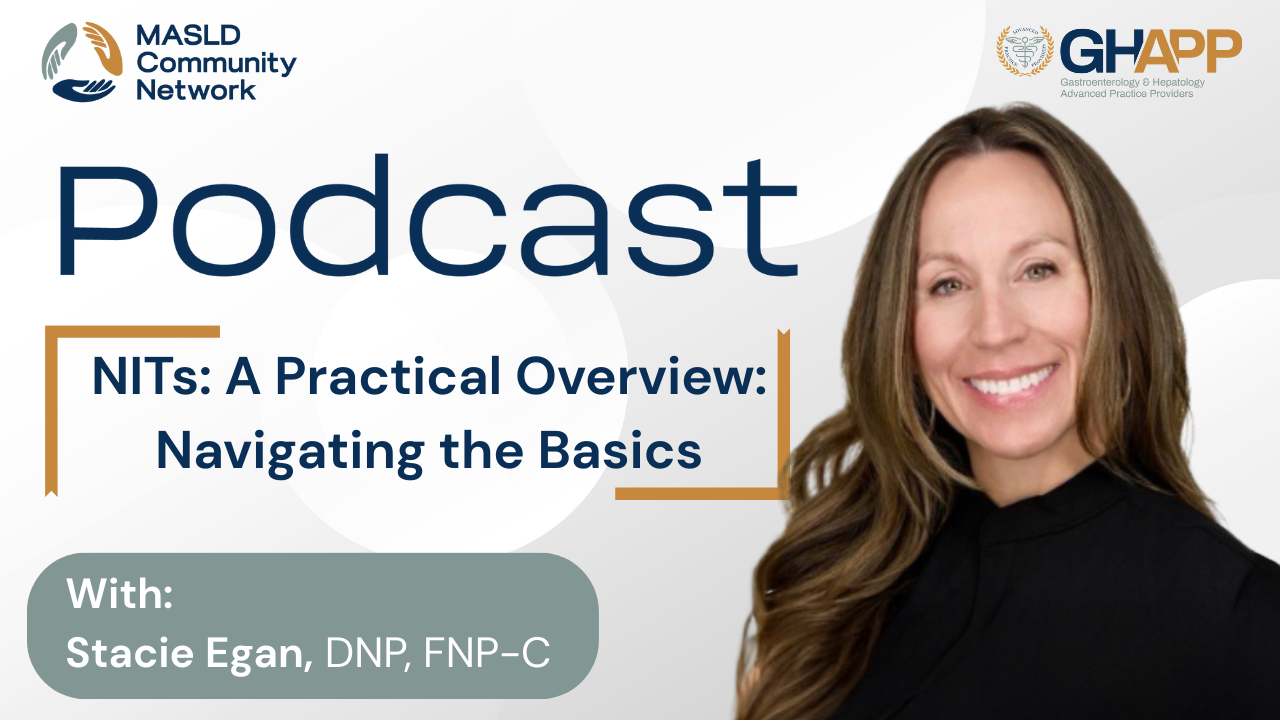
NITs: A Practical Overview: Navigating the Basics

In this educational session, Stacie Egan, NP, from Ogden Clinic Gastroenterology, explores the critical role of non-invasive testing (NITs) in diagnosing and managing MASLD (Metabolic Dysfunction–Associated Steatotic Liver Disease) and MASH (Metabolic Dysfunction–Associated Steatohepatitis). Stacy explains the key differences between MASLD—fat accumulation without active damage—and MASH, where inflammation and cellular injury drive fibrosis, cirrhosis, and hepatocellular carcinoma. Understanding this distinction is vital for early detection and intervention. This session also highlights how ALT levels, metabolic comorbidities, and alcohol use should influence decision-making, and why combining test results with clinical context ensures accurate risk stratification. Clinicians will learn how to use NITs not as standalone diagnostics, but as integrated puzzle pieces that drive earlier treatment with lifestyle modification and emerging pharmacotherapies for F2–F3 fibrosis. Perfect for APPs, NPs, and GIs managing patients with fatty liver disease, this video offers a clear roadmap to detect, monitor, and manage MASH with fibrosis—improving outcomes while minimizing invasive procedures.
Watch Now
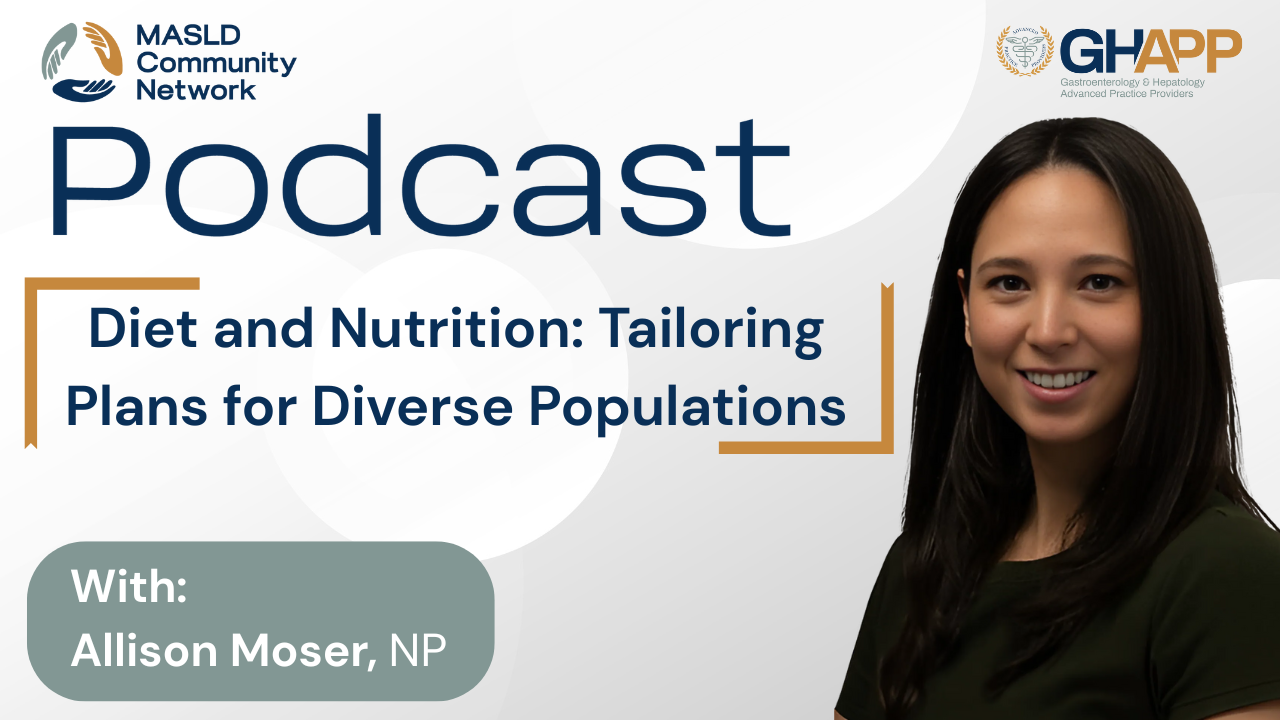
Diet and Nutrition: Tailoring Plans for Diverse Populations

In this episode, Allison Moser, NP, from Rush University Medical Center, dives into one of the most impactful aspects of MASH (Metabolic Dysfunction–Associated Steatohepatitis) management — diet and nutrition. While weight loss is often the starting point, Allison explains why sustainable liver health depends on personalized, culturally sensitive, and practical nutrition strategies. Learn how evidence-based eating patterns like the Mediterranean diet and plant-based diets can reduce hepatic steatosis, improve insulin sensitivity, and lower inflammation, even without weight loss. Allison shares actionable food swaps for diverse cultures, affordable ways to eat healthy when access is limited, and tailored recommendations for patients with comorbidities like diabetes, CKD, and cardiovascular disease. She also discusses the major role of added sugars, processed foods, and sugary or diet beverages in driving liver damage — and how to help patients make realistic, stepwise changes that last. Whether you’re an APP, NP, PA, or clinician treating patients with MASH or MASLD, this episode offers practical, evidence-based tools to improve nutrition counseling, build patient trust, and support long-term liver health.
Watch Now
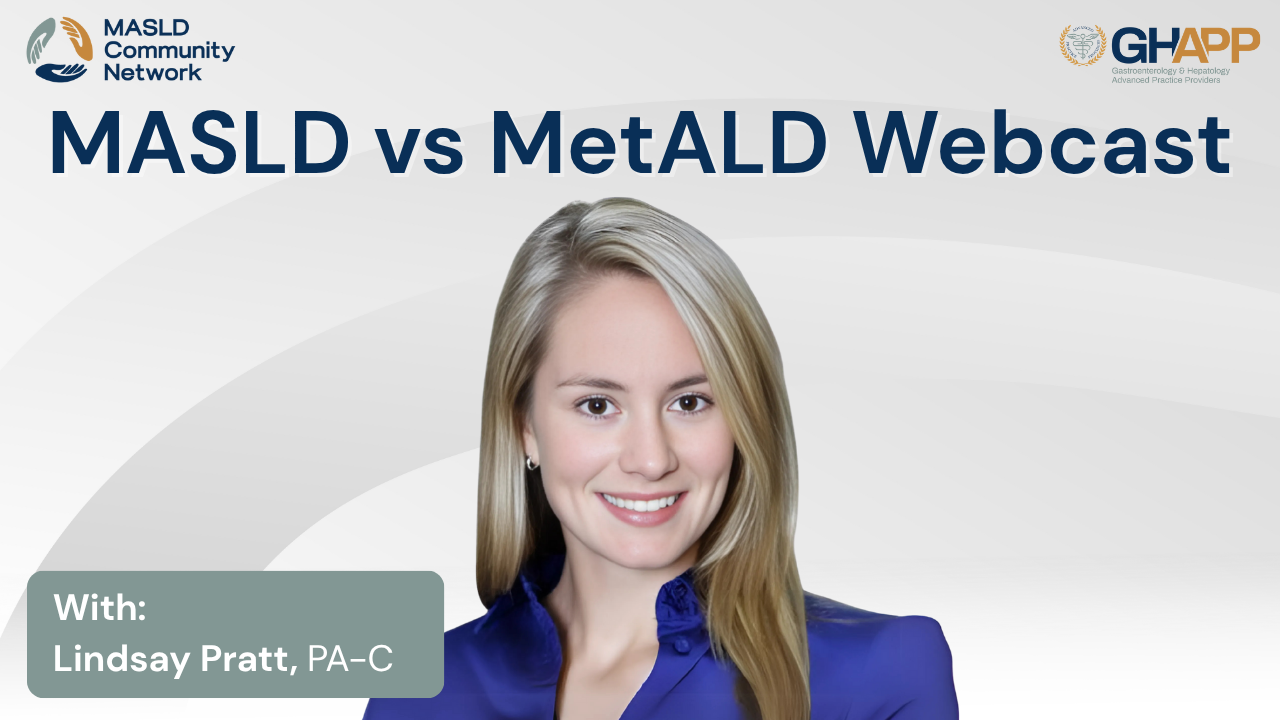
MASLD vs MetALD With Lindsay Pratt

Learn from Lindsay Pratt, PA-C at the University of Colorado Hepatology Clinic, as she explores the evolving landscape of metabolic dysfunction–associated steatotic liver disease (MASLD) and metabolic dysfunction and alcohol-associated liver disease (MetALD) in this comprehensive, case-based discussion. Drawing on over 15 years of experience in hepatology and liver transplantation, Lindsay walks through real-world evaluation and management of a 52-year-old patient with hepatic steatosis, highlighting key diagnostic clues, lab interpretations, and the importance of incorporating objective biomarkers such as PEth testing to accurately assess alcohol use. This educational session provides clarity on differentiating MASLD, MASH, and MetALD, interpreting FibroScan results, and addressing cardiometabolic risk factors like obesity, hypertension, and hyperlipidemia. Pratt also emphasizes practical treatment strategies, including lifestyle modification, GLP-1 therapy, and alcohol cessation counseling, along with considerations for emerging therapies like resmetirom (Rezdiffra). APPs and hepatology clinicians will gain valuable insights into patient communication, disease classification, and evidence-based management approaches that can help slow progression, reduce fibrosis risk, and optimize liver outcomes.
Watch Now
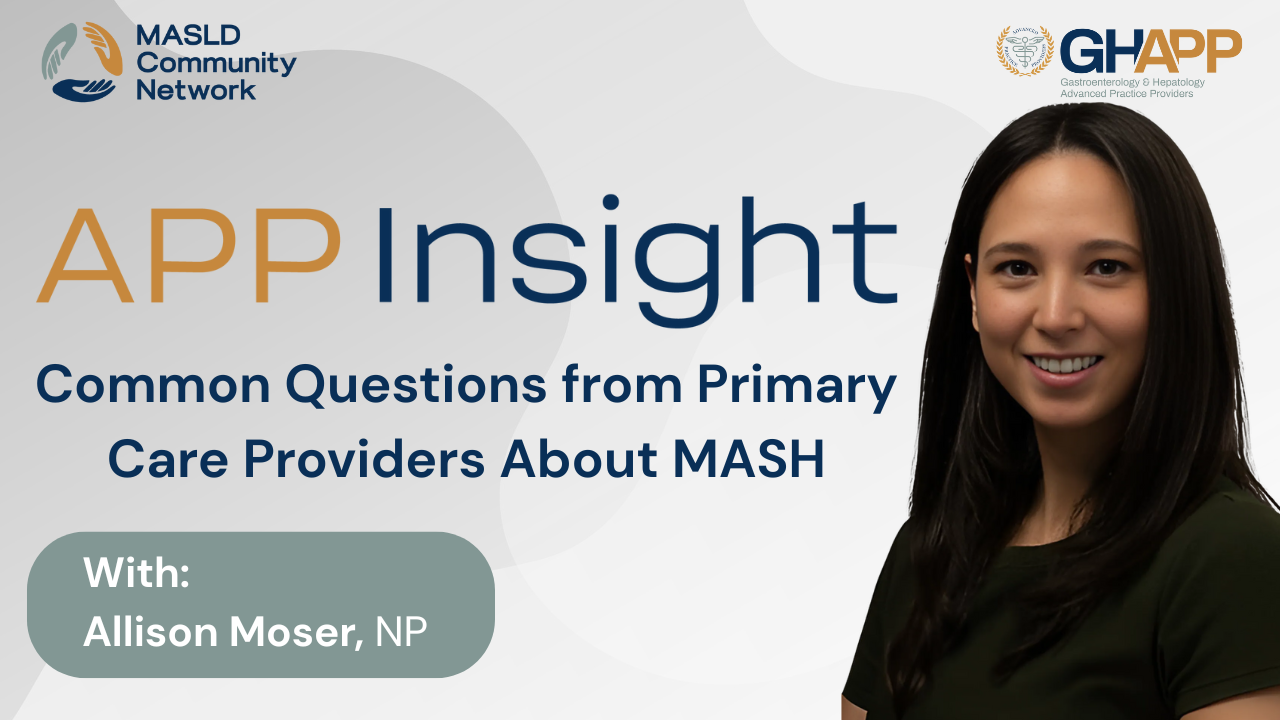
Common Questions From Primary Care Providers About MASH With Allison Moser

In this quick and practical episode, Allison Moser, a hepatology nurse practitioner at Rush University Medical Center in Chicago, answers three of the most common patient questions about metabolic dysfunction–associated steatohepatitis (MASH). She explains how MASH differs from MASLD (fatty liver disease without damage), why it develops in people who don’t drink alcohol, and how it can be reversed with lifestyle changes and new FDA-approved therapies. Allison highlights the link between MASH and metabolic syndrome conditions such as type 2 diabetes, obesity, high cholesterol, and hypertension, underscoring the importance of early identification and treatment. She also discusses the effectiveness of weight loss, dietary approaches like the Mediterranean diet, physical activity, and emerging pharmacologic therapies including resmetirom and semaglutide for patients with stage 2–3 fibrosis. Designed to keep the message simple and patient-centered, this video offers guidance for patients, families, and providers who want to better understand MASH, its risks, and how early action can reverse liver damage and prevent progression to cirrhosis.
Watch Now
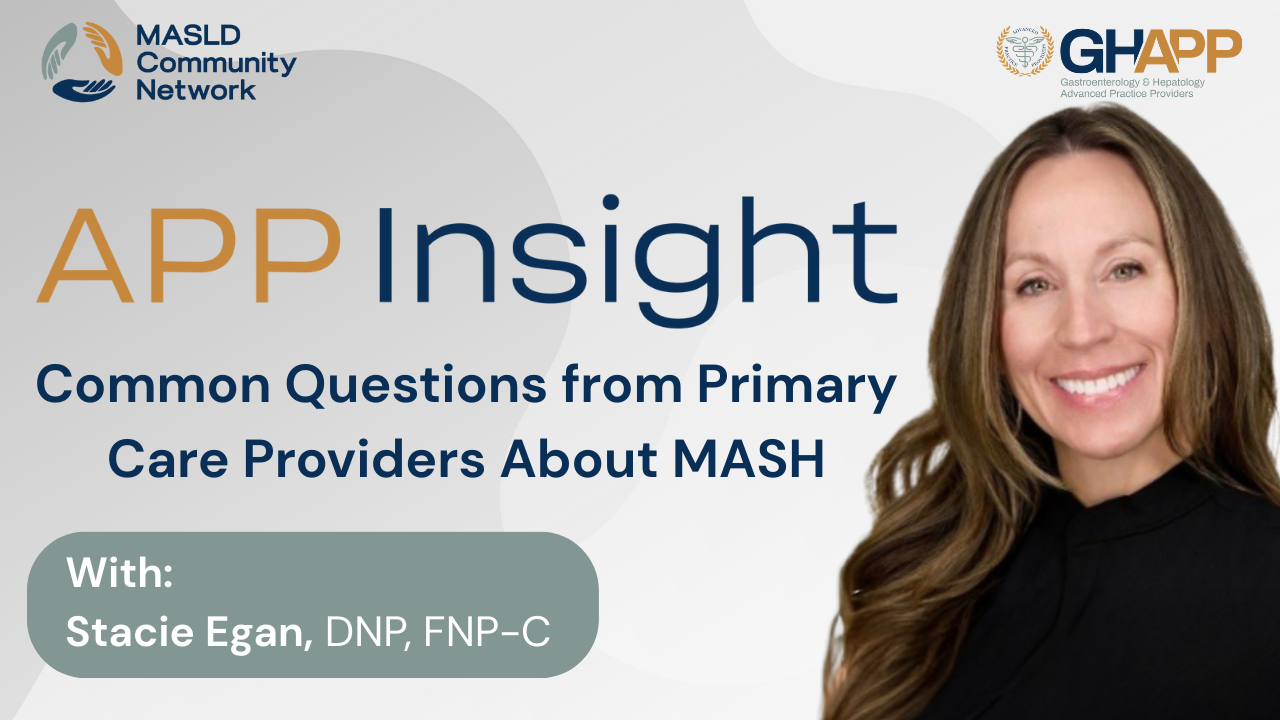
Common Questions From Primary Care Providers About MASH With Stacie Egan

In this educational session, Stacie Egan, DNP at Ogden Clinic GI in Ogden, Utah, shares practical insights on managing patients with MASH and fibrosis in clinical practice. Drawing from her experience treating patients with F2–F3 fibrosis, Stacy highlights the effectiveness of emerging pharmacotherapies and the positive outcomes she has seen in her patients. She emphasizes the critical role of primary care providers as gatekeepers in identifying at-risk patients, particularly those with metabolic syndrome, type 2 diabetes, obesity, hypertension, or hyperlipidemia. By utilizing simple tools like the FIB-4 score, primary care teams can begin the process of risk stratification and ensure that patients receive timely referrals for additional testing such as FibroScan, MRE, or liver biopsy. Stacie also discusses the importance of distinguishing between low, indeterminate, and high-risk patients, ensuring that those with advanced fibrosis (F2, F3, and F4) receive appropriate treatment, monitoring, and, when needed, referral to hepatology for transplant evaluation. This video serves as an important resource for providers across specialties, reinforcing the need for collaboration to detect and treat MASH with fibrosis early, improve patient outcomes, and help reverse steatosis and fibrosis.
Watch Now
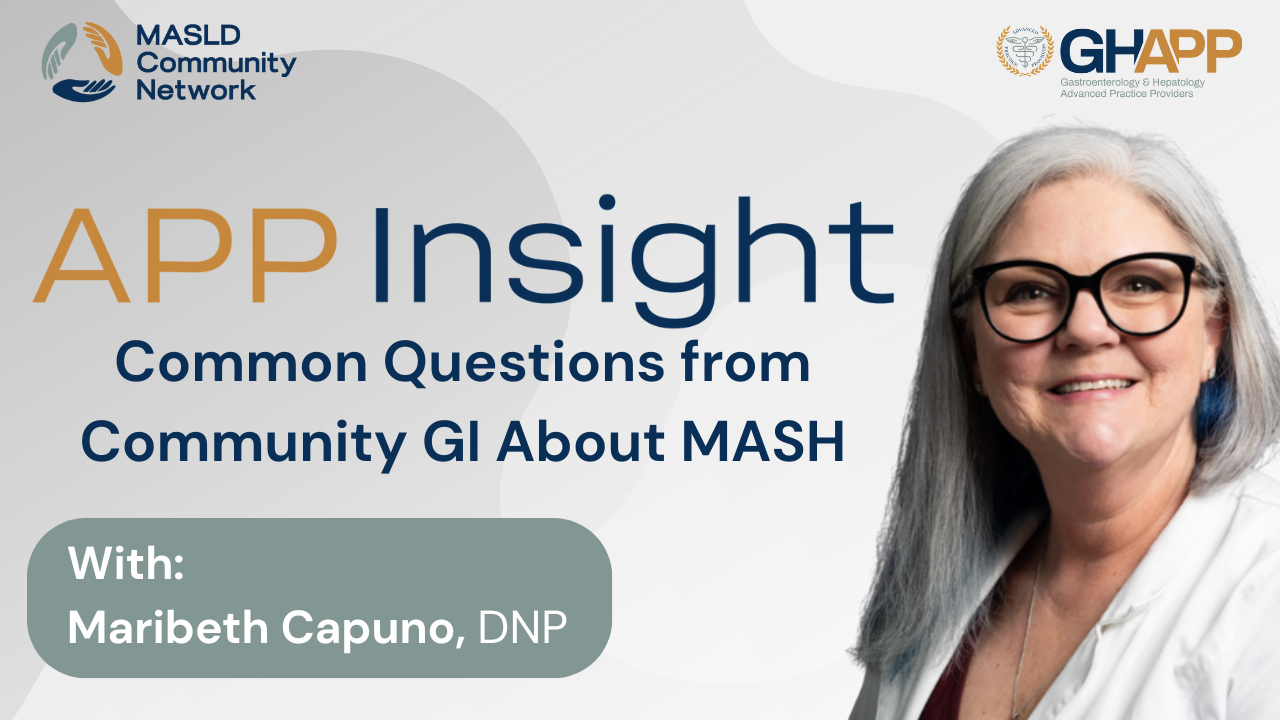
Common Questions From Community GI About MASH With Maribeth Capuno

In this educational session, Maribeth Capuno, Adult Nurse Practitioner specializing in hepatology at the Richmond VA Medical Center, answers two of the most common questions clinicians face about Metabolic Associated Steatotic Liver Disease (MASLD) and Metabolic Associated Steatohepatitis (MASH). She explains how elevated liver enzymes—particularly when ALT is greater than AST—can be an early signal to investigate further, and why obtaining a baseline ultrasound and, when possible, a FibroScan are key steps in assessing liver health. Maribeth also covers how to determine the right time to repeat non-invasive liver testing, especially in patients with higher-risk metabolic conditions such as diabetes, and highlights the role of tests like Fib-4 and the ELF test in identifying fibrosis risk. Whether you’re a healthcare provider managing patients with liver disease or someone seeking to understand the latest non-invasive approaches to MASLD and MASH, this video provides practical guidance on monitoring, testing frequency, and risk assessment strategies that can improve patient care and outcomes.
Watch Now
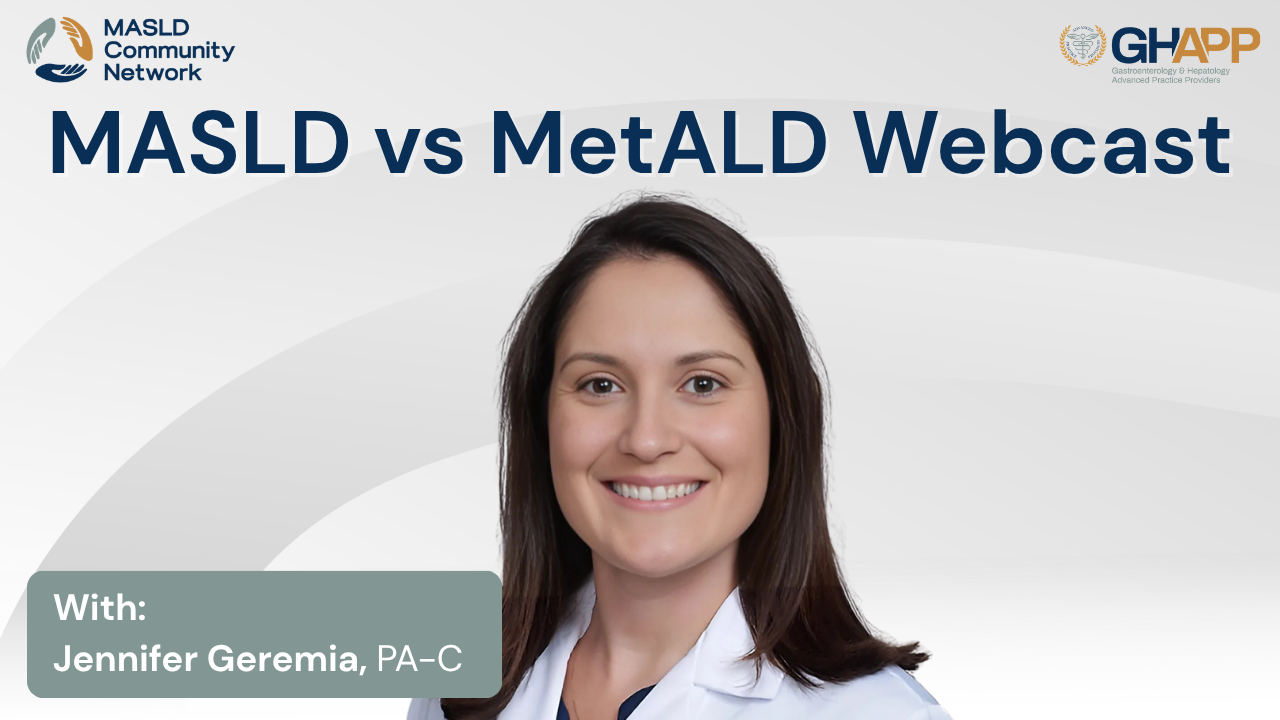
MASLD vs MetALD With Jennifer Geremia

In this GHAPP MASLD Community Network presentation, Jennifer Geremia, PA-C explains how to differentiate metabolic dysfunction–associated steatotic liver disease (MASLD) from metabolic dysfunction plus alcohol-associated liver disease (MetALD) and how to manage patients who sit on the MASLD–MetALD spectrum. Using a classic case (52-year-old with BMI 29.4, PCOS, hypertension, hyperlipidemia, ultrasound-confirmed steatosis, FibroScan 11.4 kPa [F3] and CAP 310), she shows how to combine history, “standard drink” counseling, AUDIT-C screening, and objective biomarkers like PEth to uncover under-reported alcohol use, quantify grams/day or week, and classify risk. You’ll learn practical algorithms for ruling out alternative etiologies, assessing cardiometabolic drivers, interpreting noninvasive tests, and estimating 5-year decompensation risk across MASLD, MetALD, and ALD. The session closes with actionable care steps: lifestyle and Mediterranean-style nutrition, exercise and weight-loss targets, strict alcohol cessation (and referral when appropriate), consideration of pharmacologic options in advanced fibrosis, and when to initiate HCC surveillance. Scan the QR code to confirm attendance and access more MASLD/MetALD education and resources.
Watch Now
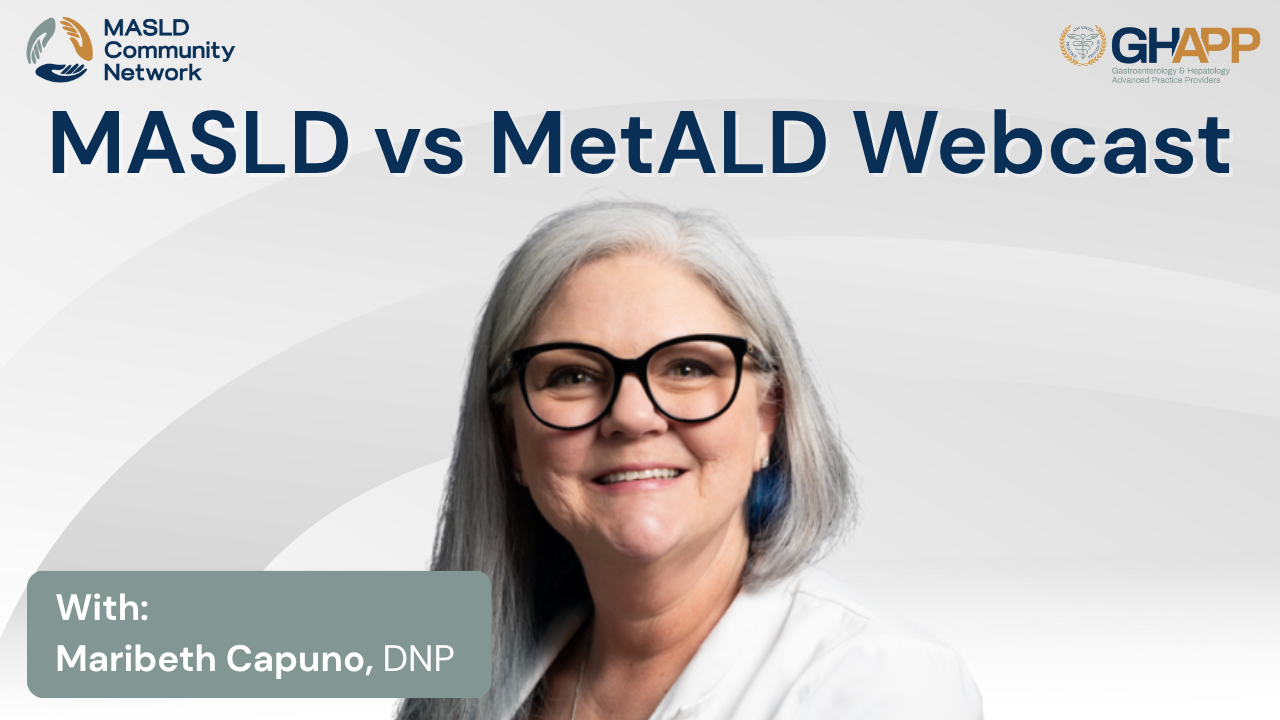
MASLD vs MetALD With Maribeth Capuno

In this case-based talk from the GHAPP MASLD Community Network, Maribeth Capuno, DNP reviews how to differentiate metabolic dysfunction–associated steatotic liver disease (MASLD) from metabolic dysfunction plus alcohol-associated liver disease (MetALD). Using a 52-year-old patient with ultrasound-confirmed steatosis, metabolic risks (PCOS, hypertension, hyperlipidemia, prediabetes), and daily wine intake, she walks through labs and noninvasive testing—FibroScan 11.4 kPa (F3 fibrosis) and CAP 310 (severe steatosis)—plus an objective PEth biomarker of 120 indicating moderate–heavy alcohol use. The session covers the SLD spectrum, “standard drink” counseling, why questionnaires (AUDIT) and biomarkers (PEth) uncover under-reported alcohol use, and how alcohol synergizes with insulin resistance and dyslipidemia to accelerate fibrosis and decompensation risk. Practical management includes Mediterranean-style nutrition, exercise with 5–10% weight-loss goals, strict alcohol cessation, medication considerations for advanced fibrosis, and HCC surveillance in F3 disease. Ideal for APPs and hepatology clinicians, this video delivers step-by-step evaluation, diagnostic criteria, and clear, patient-education talking points to improve MASLD/MetALD assessment and outcomes.
Watch Now
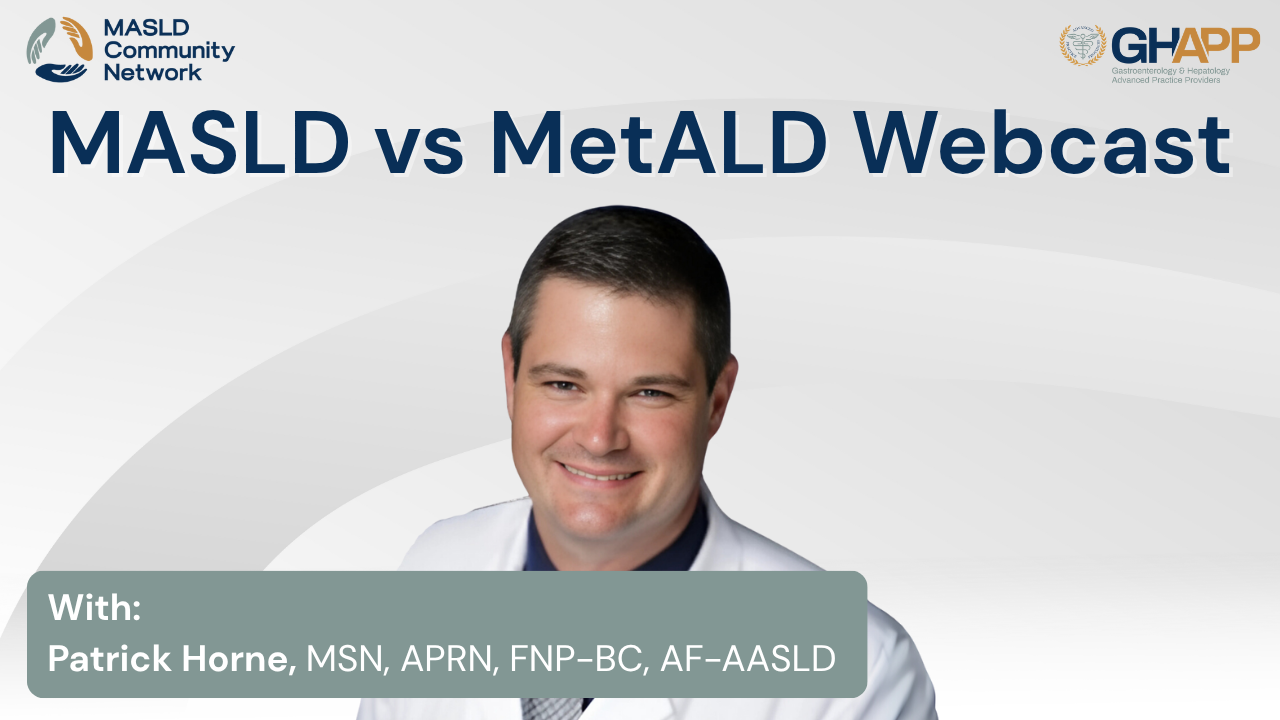
MASLD vs MetALD With Patrick Horne

In this case-based session from the GHAPP MASLD Community Network, Patrick Horne, NP explains how to differentiate metabolic dysfunction–associated steatotic liver disease (MASLD) from metabolic dysfunction plus alcohol-associated liver disease (MetALD). Through the story of a 52-year-old patient with F3 fibrosis and severe steatosis, he reviews the modern SLD framework, metabolic risk factors (e.g., BMI, PCOS, hypertension, hyperlipidemia), and how alcohol intake interacts with insulin resistance, the gut microbiome, and hepatic lipid handling to accelerate inflammation and fibrosis. Patrick demonstrates practical tools—clear “standard drink” counseling, thorough history, AUDIT-C screening, and objective biomarkers like PEth—to uncover under-reported alcohol use and classify patients on the MASLD–MetALD–ALD spectrum. Management takeaways include Mediterranean-style nutrition, exercise and weight-loss targets, consideration of pharmacologic options in advanced fibrosis, firm guidance on alcohol cessation, and nuanced discussion of HCC surveillance in F3 disease. Ideal for APPs and hepatology clinicians, this talk delivers actionable algorithms, definitions, and trial-readiness considerations to standardize MetALD assessment and improve outcomes in steatotic liver disease.
Watch Now
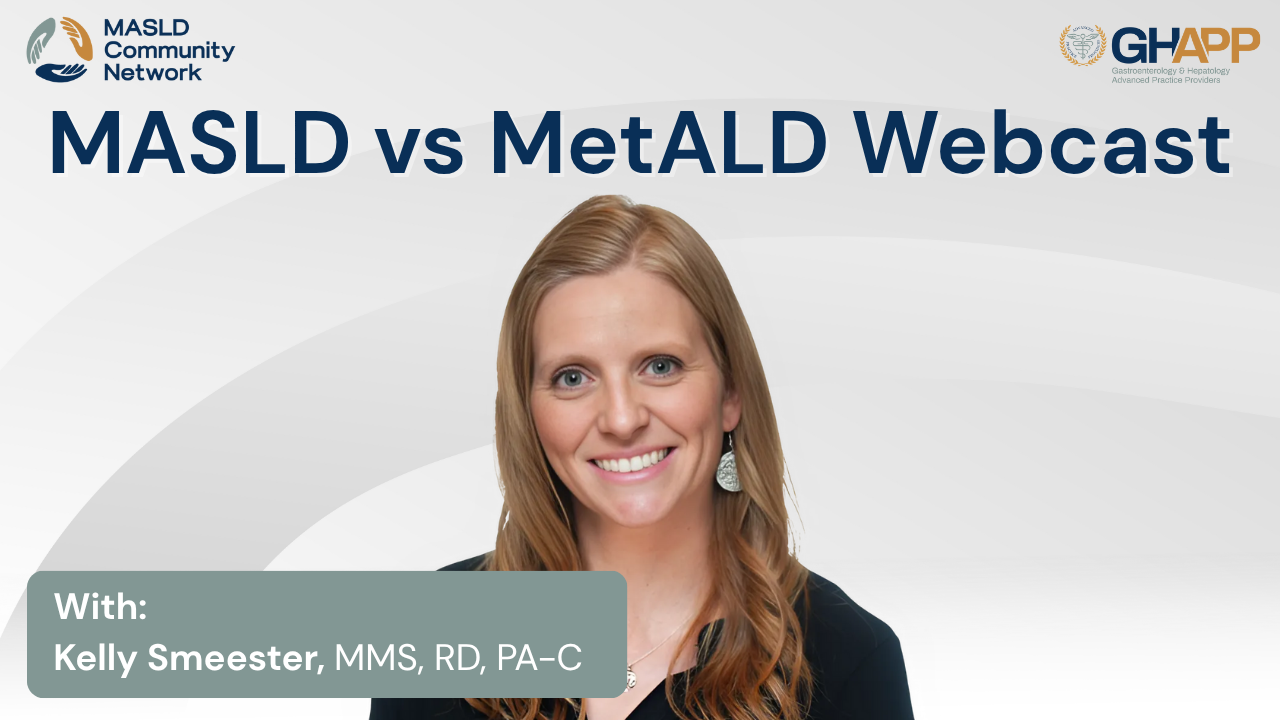
MASLD vs MetALD With Kelly Smeester

In this session from the GHAPP MASLD Community Network, Kelly Smeester, PA-C at South Denver Gastroenterology, reviews a patient case to highlight the overlap between metabolic dysfunction–associated steatotic liver disease (MASLD) and metabolic dysfunction plus alcohol-associated liver disease (MetALD). Using real-world labs, FibroScan values, CAP scores, and the PEth biomarker, she explains how clinicians can distinguish MASLD from MetALD and alcohol-related liver disease. The discussion covers key metabolic risk factors such as PCOS, hypertension, and hyperlipidemia, the impact of moderate alcohol intake, and how these drivers accelerate fibrosis progression and increase the risk of decompensation. Viewers will learn how to evaluate alcohol use through standardized definitions, clinical questionnaires, and biomarkers, as well as best practices for patient education, lifestyle counseling, and management, including diet, exercise, pharmacologic options, and hepatocellular carcinoma (HCC) surveillance. This case-based talk emphasizes why accurate diagnosis and objective assessment of alcohol consumption are essential for both clinical care and research in steatotic liver disease.
Watch Now
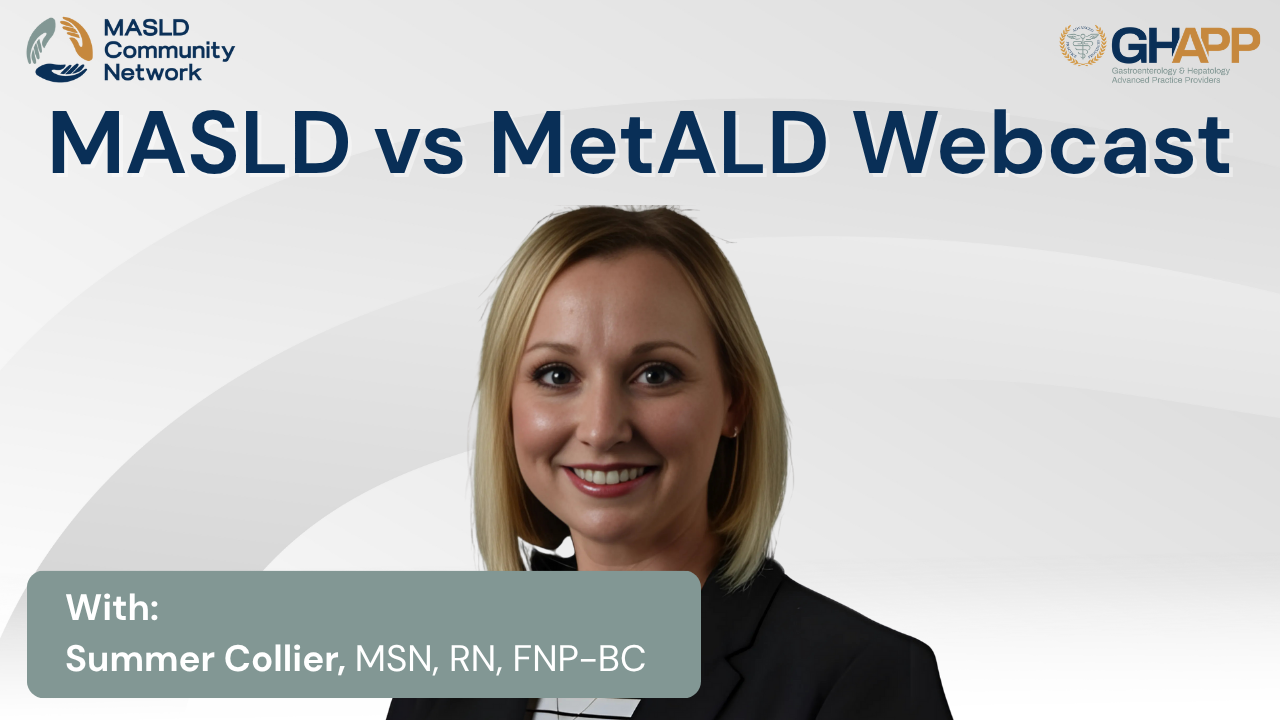
MASLD vs MetALD With Summer Collier

In this educational session from the GHAPP MASLD Community Network, Summer Collier, NP at UC San Diego Health, explores the overlap between metabolic dysfunction–associated steatotic liver disease (MASLD) and metabolic dysfunction plus alcohol-associated liver disease (MetALD) through a detailed clinical case study. Using real-world patient data, she highlights key considerations for evaluating, diagnosing, and managing steatotic liver disease, with special focus on teasing out the dual drivers of metabolic risk factors and alcohol consumption. Viewers will learn about diagnostic tools such as FibroScan, CAP scores, and PEth testing, and how these objective biomarkers help distinguish true MASLD from alcohol-driven disease. The discussion also covers pathophysiology, risk of fibrosis progression, patient counseling on lifestyle and alcohol cessation, current treatment recommendations, and hepatocellular carcinoma (HCC) screening in advanced fibrosis. Whether you are a hepatology provider, APP, or clinician interested in MASLD and MetALD, this session provides practical insights into patient education, disease classification, and the importance of standardized definitions for clinical care and research.
Watch Now
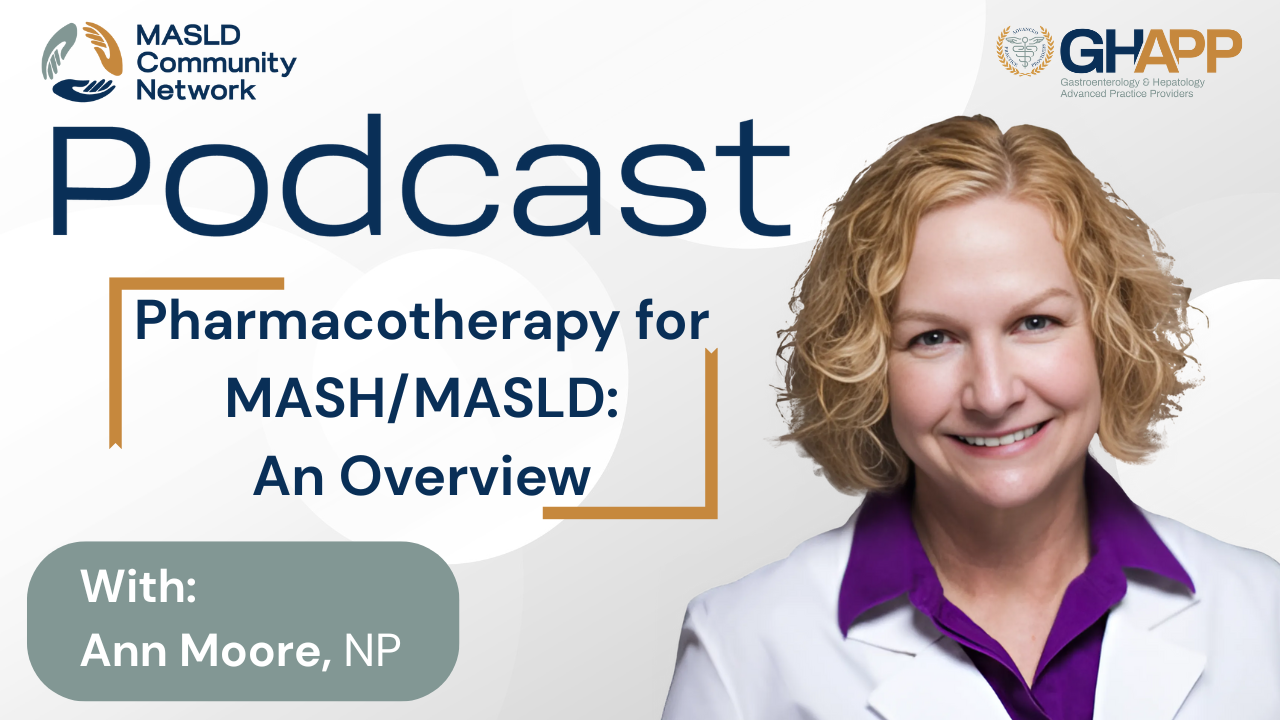
Pharmacotherapy for MASH/MASLD: An Overview

In this expert discussion, Anne Moore, NP with Arizona Liver Health in Phoenix, shares key insights into the evolving landscape of pharmacotherapy for MASH and MASLD. She explains the primary histological endpoints that matter most in clinical trials—MASH resolution and fibrosis improvement—and why these markers are critical for both regulatory approval and long-term patient outcomes. Anne highlights the approval of resmetirom, the first FDA-approved treatment for MASH with F2–F3 fibrosis, and reviews how it works as a selective THR-beta agonist to reduce liver fat and inflammation while improving fibrosis. Drawing on Phase 3 trial data, she outlines its efficacy, safety profile, and side effects, as well as strategies for monitoring patients through non-invasive testing, liver chemistries, and metabolic risk factors. This session also explores which patients are most appropriate candidates for MASH pharmacotherapy, with a focus on those at high risk of progression but still early enough in their disease to benefit. For advanced practice providers and hepatology specialists, this video provides a clear, practical roadmap to identifying, treating, and monitoring patients with MASH in everyday clinical practice.
Watch Now




